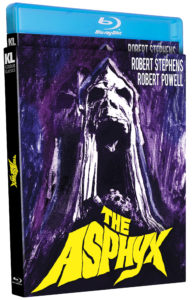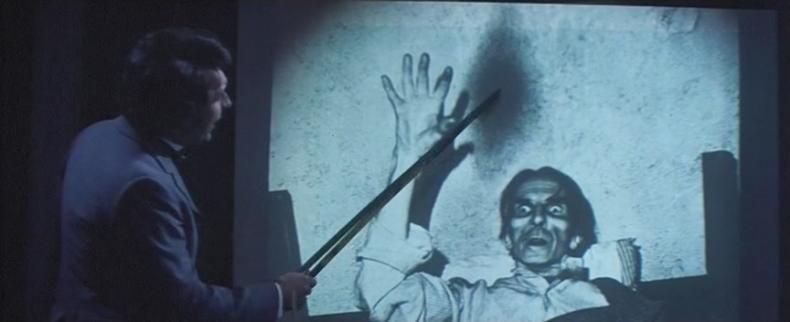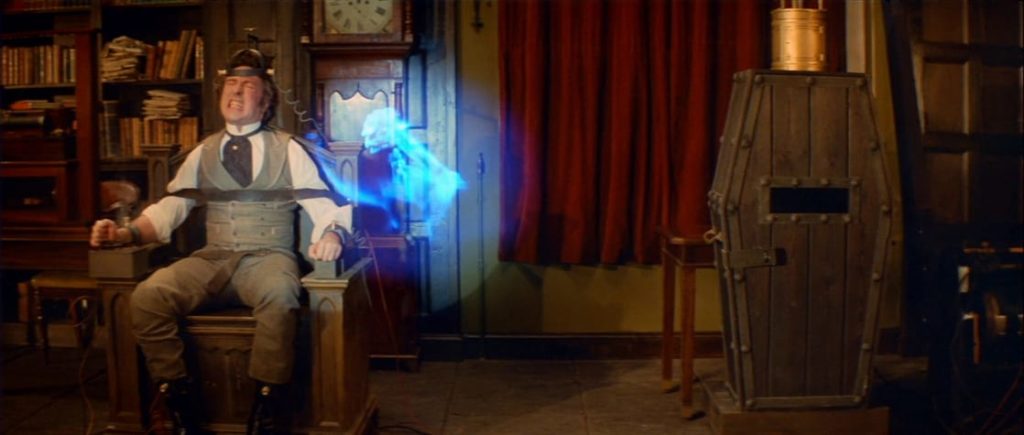For These British men of Wealth and Science, Gaining Immortality is a pain in the Asphyx
DIRECTED BY PETER NEWBROOK/1972
BLU-RAY STREET DATE: JANUARY 31, 2023/KL STUDIO CLASSICS

Curious how to pronounce “asphyx”? Just watch 1972’s supernatural gothic horror film, The Asphyx. In it, stars Robert Stephens and Robert Powell say “asphyx” to one another at least thirty times each. The humorless gobbledygook they’re going on about may not be clear, but the exact pronunciation of the film’s title, a daunting mouthful of consonants, most certainly is. It’s almost as though the actors practiced enunciating the word to be extra sure that they were saying it properly.
So what the heck is the asphyx of The Asphyx, anyway? Per one of the British film’s alternate titles, it’s a “spirit of the dead”. That’s per Greek mythology, anyhow. The spirit in question isn’t the spirit of a dead individual; rather, it’s a spirit that descends upon one’s body at the moment of death, seeking to retrieve the soul. Everyone has their own asphyx, apparently just hanging around waiting for us to kick it. Asphyxes have only one job, and they are not our friends. Also, according to this film, they look like angry noncorporeal lizard muppets.
Sir Hugo Cunningham (Robert Stephens) is a man of wealth and taste. It’s 1875 in the rainy old country, and the great philanthropist’s paranormal society of which he is a member believes it’s made a stunning discovery. In their recent practices of photographing people at the moment of their deaths, they’ve repeatedly spotted a mysterious black blotch near the head. No sooner do they determine that this must be the soul exiting the body when Sir Cunningham tragically films his grown son’s death with his rudimentary, anachronistic motion picture camera. The black blotch flies at the son, not away from him. There’s only one possible explanation: it’s the asphyx.

Sir Cunningham’s growing obsession with the asphyx becomes increasingly disturbing to his ward and assistant, Giles (Robert Powell, looking mod/dapper). Hugo has become fixated on the notion of capturing one’s asphyx and locking it up. Because, it’s reasoned, if the asphyx can’t carry your soul away, you can’t die. Viola- immortality!
It takes Giles a bit longer to arrive at this fixation, but soon enough, he’s aiding the attempts. To a large degree, he feels he must, as he intends to wed Christina (Jane Lapotaire), Sir Hugo’s daughter (his stepsister… old timey family dynamics in action). Then comes the bargain: if Giles will serve as the necessary devoted, essential second set of hands during the precarious Ghostbusters-esque apparition catching, then Sir Hugo will make them immortal. The catch? To recieve eternal life, they first must die. Not a figurative Christian death unto oneself, but actual (near) death. The warped bargain must be literal. This, after all, is a horror film.
But wait… is The Asphyx really a horror film? Frankly, it only barely registers as one. Although famed cinematographer Freddie Young cultivates a bygone vibe of upper crust precarious intellectuality- and in glorious widescreen- director Peter Newbrook appears to be adrift in terms of compelling visual storytelling. For a film that is by nature heavy on exposition, the consistently bland staging of characters standing around talk talk talking is detrimental. It’s likely no coincidence that this wound up being Newbrook’s only directing credit. Newbrook made a greater mark elsewhere as a producer and second unit director (of the visually sumptuous Lawrence of Arabia, no less).

Some laud The Asphyx as a forgotten gem of spookiness, which is enough to explain its previous inclusion in horror label Redemption’s Blu-ray line a decade ago. That version can still be had for a very reasonable price, but KL Studio Classics’ new Blu-ray release is preferable for several reasons. Never mind the slipcover (it has one), here’s two different cuts and a commentary.
While the “standard” UK cut is a brilliant-looking transfer, the notably longer US cut is filled out with jarringly inserted smudgy, lousy-quality standard definition footage of the reinstated bits. Novelist/critic Kim Newman and writer/editor Stephen Jones are together on the new audio commentary track, which plays out over the longer version. It’s another hyper-caffeinated freewheeling chat by these two, which is welcome insofar as they are some of the world’s foremost steel-trap-memory experts on this sort of thing. But, when it comes to the draggy pacing of this film, taking in their rambings alongside it feels like a low-level sensory assault. Newman at one point speculates that the UK version is only cut because it was too boring. None of the extra content patched back into the representation of the longer version is by any means sensationalist or controversial. It’s just more.
If The Asphyx has a saving grace, it’s in its casting. Stephens, a renowned stage actor who’d just gone through the wringer making Billy Wilder’s great The Private Life of Sherlock Holmes, gives his all to this quite lesser material. The same is true of Powell, who’s face and voice can’t help but prove enigmatic. Although far too Caucasian and European for the role, he nonetheless achieved a certain immortality playing Christ in Franco Zeffirelli’s 1977 epic TV miniseries Jesus of Nazareth. The two leads mesh well in this, maintaining an unflinching seriousness that this review could not. While it depicts a misguided quest for immortality, The Asphyx (prounced “ahs-SFIX”, by the way) never comes close to approaching the golden grailed tropic of Sir Galahad.

